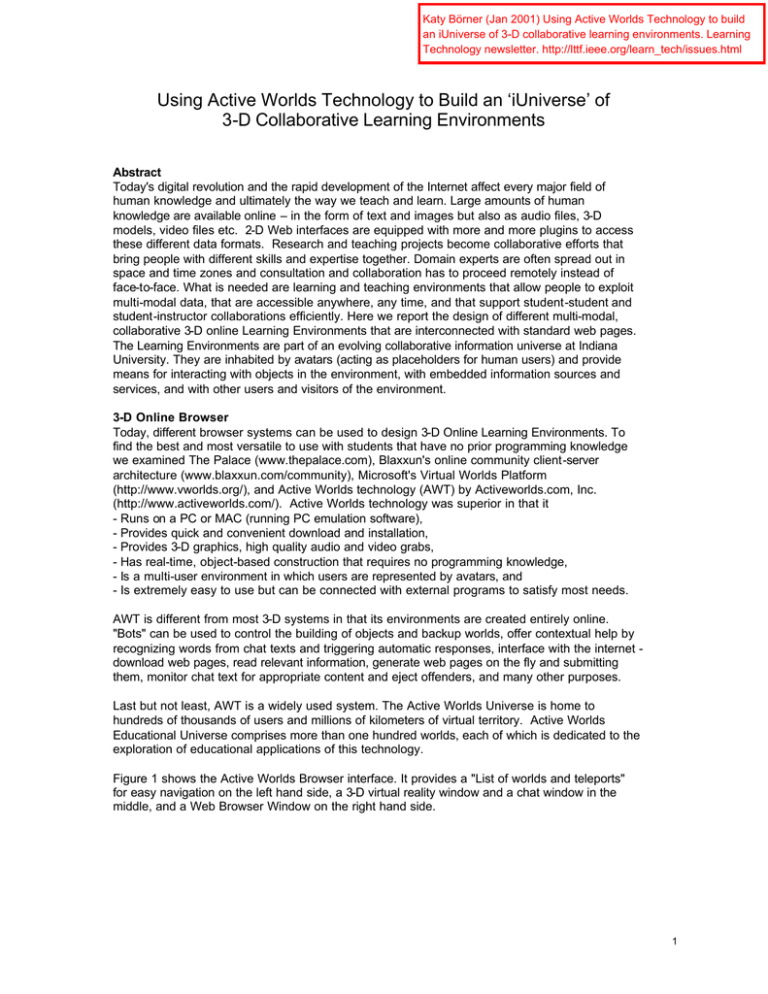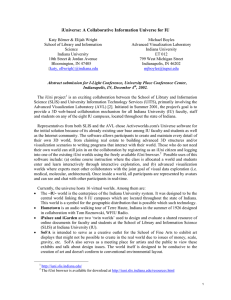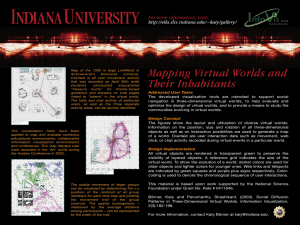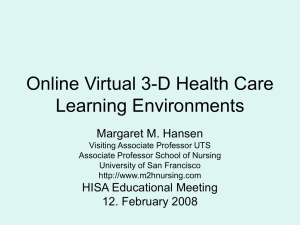Katy Börner (Jan 2001) Using Active Worlds Technology to build
advertisement

Katy Börner (Jan 2001) Using Active Worlds Technology to build an iUniverse of 3-D collaborative learning environments. Learning Technology newsletter. http://lttf.ieee.org/learn_tech/issues.html Using Active Worlds Technology to Build an ‘iUniverse’ of 3-D Collaborative Learning Environments Abstract Today's digital revolution and the rapid development of the Internet affect every major field of human knowledge and ultimately the way we teach and learn. Large amounts of human knowledge are available online – in the form of text and images but also as audio files, 3-D models, video files etc. 2-D Web interfaces are equipped with more and more plugins to access these different data formats. Research and teaching projects become collaborative efforts that bring people with different skills and expertise together. Domain experts are often spread out in space and time zones and consultation and collaboration has to proceed remotely instead of face-to-face. What is needed are learning and teaching environments that allow people to exploit multi-modal data, that are accessible anywhere, any time, and that support student-student and student-instructor collaborations efficiently. Here we report the design of different multi-modal, collaborative 3-D online Learning Environments that are interconnected with standard web pages. The Learning Environments are part of an evolving collaborative information universe at Indiana University. They are inhabited by avatars (acting as placeholders for human users) and provide means for interacting with objects in the environment, with embedded information sources and services, and with other users and visitors of the environment. 3-D Online Browser Today, different browser systems can be used to design 3-D Online Learning Environments. To find the best and most versatile to use with students that have no prior programming knowledge we examined The Palace (www.thepalace.com), Blaxxun's online community client-server architecture (www.blaxxun.com/community), Microsoft's Virtual Worlds Platform (http://www.vworlds.org/), and Active Worlds technology (AWT) by Activeworlds.com, Inc. (http://www.activeworlds.com/). Active Worlds technology was superior in that it - Runs on a PC or MAC (running PC emulation software), - Provides quick and convenient download and installation, - Provides 3-D graphics, high quality audio and video grabs, - Has real-time, object-based construction that requires no programming knowledge, - Is a multi-user environment in which users are represented by avatars, and - Is extremely easy to use but can be connected with external programs to satisfy most needs. AWT is different from most 3-D systems in that its environments are created entirely online. "Bots" can be used to control the building of objects and backup worlds, offer contextual help by recognizing words from chat texts and triggering automatic responses, interface with the internet download web pages, read relevant information, generate web pages on the fly and submitting them, monitor chat text for appropriate content and eject offenders, and many other purposes. Last but not least, AWT is a widely used system. The Active Worlds Universe is home to hundreds of thousands of users and millions of kilometers of virtual territory. Active Worlds Educational Universe comprises more than one hundred worlds, each of which is dedicated to the exploration of educational applications of this technology. Figure 1 shows the Active Worlds Browser interface. It provides a "List of worlds and teleports" for easy navigation on the left hand side, a 3-D virtual reality window and a chat window in the middle, and a Web Browser Window on the right hand side. 1 *** insert Figure 1: http://ella.slis.indiana.edu/~katy/iUni/browser.jpg here *** Figure 1: Active Worlds Browser interface showing the ‘Disaster Area’ iUniverse: A Collaborative Information Universe at Indiana University In Fall 2000, the User Interface Design course at the School of Library and Information Science, Indiana University was taught using AWT. Students learned how to design standard web pages and JavaScript first. In the 4th Lab session, students entered the 'iuni' world that was set up especially for this class. They learned to navigate in the 3-D space and to manipulate objects. During Lab they started to design their own virtual homes in cyberspace as well as menu systems for easy access of information (via web links) and places (via teleports). Snapshots can be accessed at http://ella.slis.indiana.edu/~katy/iUni/pics.html. As part of their project work, they examined and evaluated other worlds in the Eduverse universe. For their final project, students offered faculty on campus to design customized 'Learning Environments' for different classes. The result is a ‘Natural Disaster Area’, a ‘Science House’, a ‘Quest Atlantis’ portal to different theme parks for kids, an ‘Art Café’, and a ‘Virtual Collaboration Area’. The ‘Natural Disaster Area’ was designed by Maggie Swan. It teaches about natural disasters and the different levels of damage they can do to various types of buildings/structures in a realistic setting. The intended user group is youths at the Boys & Girls Club in BL (Coordinated with Quest Atlantis see below). An accompanying website can be found at http://vws3.avl.indiana.edu/team2/home.html. The Science House was build by Kent Holaday. It resembles a 3D Virtual Science Dictionary. Different objects in this house are linked to web pages describing function and science behind diverse household appliances. Intended user groups are general public, science students, and science educators (http://vws3.avl.indiana.edu/team3/scihouse.html). The ‘Natural Disaster Area’ and the Science House have been developed in collaboration with Dr. Bill Harwood at the School of Education, IU. Quest Atlantis is the name of a portal site to different Educational Theme Parks for Kids 2 Designers are Hakan Tuzun & Mark Dial in collaboration with Dr. Sasha Barab, School of Education, IU. The intended user group is children, ages 6-14 at the Bloomington Boys & Girls. Details can be found at http://vws3.avl.indiana.edu/team1/. Lilly Lu, Gertrud Peters & Sy-Miaw Lin, designed the Art Café. Its goals are to sharpen viewers' sensibility & perception of artwork; build viewers' visual vocabulary & their visual concepts; enhance viewers' understanding & appreciation about art work; and assist viewers in organizing & verbalizing their aesthetic experience (http://vws3.avl.indiana.edu/team5/www/artcafeweb/Homepage.html). Last but not least there is a ‘Virtual Collaboration’ area that was designed by Randy Fisher & Tim Bowman in collaboration with Allan Dennis, Kelley School of Business. It is supposed to provide a 24/7, worldwide accessible meeting space for business professionals (http://vws3.avl.indiana.edu/team4/index.html). Brian Horvitz, PhD student in Instructional Systems Technology, IU advised the students in the instructional design of their projects. Taken together, the different Learning Environments present instructional material in a 3dimensional, multi-modal, and highly interactive space that can be experienced collaboratively. Students can visit environments and interact with events that distance, time, or safety factors normally preclude (e.g., visit a disaster area showing the effect of tornados). They can collaborate online with other students or teachers (e.g., attend artist talks in the Art Cafe, meet with remote collaborators in the Virtual Collaboration Area). Summary Students taking the User Interface Design course had hands-on experience in the design of intuitive and effective, multi modal interfaces. They needed to decide which information to present as text, images, sounds, video grabs in 3D or on a web page and how to effectively use web links, warps, teleports, JavaScript, etc. to achieve effective interactivity. The close collaboration with faculty from other departments provided a project management challenge. Initial feedback on the course shows that almost all students found the design of the 3D environment the most interesting and challenging part of the course. Research on virtual environments for education (Winn & Jackson, 1999; Online Library VLearn 3D) has suggested that VE’s have a number of properties that help students understand scientific concepts and principles. First empirical evaluations with visitors of the Learning Environments confirm that the virtual experience is far more engaging than traditional lecture and discussion methods. Detailed evaluations and usability studies are planned. References Activeworlds.com, Inc.: http://www.activeworlds.com iUniverse: A collaborative Information Universe at Indiana University: http://ella.slis.indiana.edu/~katy/iUni Online Library VLearn 3D: http://www.vlearn3d.org/library/case_studies.html Winn, W.D. & Jackson, R. (1999). Fourteen propositions about educational uses of virtual reality. Educational Technology, 39 (4), 5-14. Katy Börner Indiana University, USA katy@indiana.edu 3






